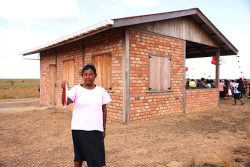ASL CEO Captain Mazahar Ally says the facility will lead to significant savings that will keep air transportation affordable and it would allow for a far more efficient turnaround of ASL’s aircraft in-between flights and which can be serviced independently from other fuel suppliers.
In a statement yesterday announcing the completion of the fuel farm, Ally also said he felt that aircraft operators can now choose their fuel service provider since the “monopoly” on fuel handling has been removed.
Currently, all the fuelling operations at the aerodrome are conducted by the Carib-bean Aviation Maintenance Services Ltd (CAMSL) and Rubis West Indies. CAMSL, which owns and operates a fuel farm at Ogle Airport, is the authorised agent of Rubis West Indies, which is the authorised supplier of aviation fuel products to Ogle Airport.
ASL and the management of the airport were engaged in a public dispute over fuel supplies, with the charter company saying it was cheaper to source its own supply. The dispute climaxed in August, 2011, when a tanker laden with fuel for ASL rammed through the padlocked gate of the airport. The incident occurred days after a previous delivery attempt was intercepted.

According to the Ogle Airport Operations Manual, only those companies approved by Ogle Airport Incorporated and the Director General of the Guyana Civil Aviation Authority (GCAA) as fuel handling agents at Ogle Airport may engage in the handling, receiving, storing and dispensing of fuel.
Construction of the 100 x 100 sq ft facility started in July last year, according to ASL, which pegged the cost at US$750,000, equivalent to $152,961,643. ASL noted that the facility will help fuel the further expansion of ASL at Ogle as it looks to acquire three airside lots to accommodate the growing fleet of airplanes and helicopters and a further three acres of non-airside space to ease parking problems and cargo storage for customers.
It said the facility would handle both Jet A-1 fuel for turbine engine aircraft and Avgas 100 LL for piston engine aircraft. It added that the tank farm comprises 4 tanks with a total capacity of 40,000 US gallons for Jet A-1 is and 20,000 US gallons for Avgas 100 LL.
All tanks are of the UL-142 double wall canopy design-type, which satisfies the international and national regulatory standards for environmental protection, it explained, while noting that the canopy, which is an extension of the tank shell, offers much needed protection over the equipment area.
ASL further said the tanks have all the necessary safety features, including the high-level shut-off system to prevent tank overfill. “The design and layout of the tanks is compliant with occupational health and safety requirements to ensure the health and safety of ASL personnel who will be operating and maintaining the facility,” it added, while noting that the 300 GPM Jet and 200 GPM Avgas Bulk loading systems are fitted with explosion-proof motors and provide excellent filtration with the Morrison pump inlet strainers.
According to ASL, its staff has had practical fuel handling experience over the past few decades and has benefited from training by internationally-qualified fuel consultants brought in by Rubis, GuyOil and the Guyana Energy Agency (GEA).
ASL will host a three-day Aviation Fuel Handling course, scheduled for March 16 to March 18, to augment the capacity of its personnel for the safe handling of aviation fuel. It said this course will be conducted by Global Aviation Fuel Consultant Ravin Apadoo from Fuel Solutions Inc, Canada. The Guyana Civil Aviation Authority (GCAA) and GEA will be sending two representatives each to the course, it noted.







